Each year, this unique event features a distinct gathering of recognized artists, collector cars, and automotive enthusiasts, showcased on the streets of the Carmel Arts & Design District. Artomobilia boasts one of the most eclectic gatherings of original, period-correct cars anywhere, including Supercars, Exotic, Sports Cars, Classics, Racers, Historically Preserved, Indiana Built, Sedan/Coupe, and more.
Featured Classes
Each year Artomobilia highlights a selection of automotive anomalies that are as interesting as they are distinct. This year, we’ll feature the 50 years of the Mustang brand as the featured marque, as well as Carroll Shelby Cars, car designs spanning decades in the Then & Now class, and finally, young automotive enthusiasts in the Next Generation class.
Judged Classes
With 20 different judged classes, the Artomobilia delivers an eclectic mix of original and restored, period-correct, automobiles that appeal to every taste. From the iconic Deusenbergs in the Classic Car class to the most modern Ferraris in the Supercar class to the unforgettable Corvettes in the American Sports Car class to enthusiastic Jaguars and Healeys of the European Sport Car class. And, when you’re done with those…we have 16 more classes to enjoy.
Car Corrals
Enthusiast and collector cars come in all shapes and sizes, and our car corrals feature brand-specific examples across 25 or more different corrals. While these are not formally judged, they represent the best examples of what is going on in national and local car clubs, as well as provide a great opportunity to see, firsthand, how you can participate in the car hobby.
Exotic Motorcycles
Nothing adds to Artomobilia like enthusiast and collector exotic motorcycles. Whether you’re into the classics, or love state-of-the-art performance, you’ll enjoy some of the most distinct motorcycles from around the world appropriately featured throughout the Indiana Design Center.
Shopping and Dining
Unlike any other event in the Midwest, the Artomobilia features great shopping and dining opportunities among the many local business that line the streets of the Arts & Design District. From antiques to fine art or burgers to sushi, there is something for every taste at the Artomobilia.
Featured Artist
The Carmel Artomobilia is designed to celebrate automotive art and design, and there’s no better way to celebrate this than to highlight nationally recognized, as well as up-and-coming, artists and their work. For 2014, the Artomobilia will feature a number of artists, and their art, in the months preceding the show, as well as on the day of the show.
Tom Havlasek Art
Born in Brno, Czech Republic, Tom has been passionate about motor sports from an early age. As a child, he grew up near the Brno Circuit, where he and his father spent nearly every weekend together at the track enjoying the atmosphere of both the race course and the races. The Artomobilia commissioned Tom Havlasek to design a distinct set of paintings that highlights both the Featured Marque for 2014 and the landmark “arches” within Carmel Arts & Design District. In his unique form, Tom perfectly captures the essence and beauty of the 1967 Ford Mustang specialty car, the Shelby GT500.
Event Parking
The Carmel Artomobilia is presented on the streets of the Carmel Arts & Design District. Main Street and Rangeline Road, between the arches, will be closed to traffic beginning at 6 a.m. on Saturday, August 23 and will re-open at approximately 7 p.m. that evening. Due to the popularity of the event, visitor parking can be challenging during the middle of the day. Apart from street parking available on the residential streets parallel to Main Street and Rangeline Road, visitors are invited to park in the Carmel High School parking lot, the Carmel Library, the Carmel Elementary School (after 12 noon), as well as the Carmel City Center and the Center for the Performing Arts multi-level parking garage. Please plan to arrive late morning for the best parking opportunities.
 The Years Behind the Gears: A Tale of Two Cars and the Men Who Drive Them.
The Years Behind the Gears: A Tale of Two Cars and the Men Who Drive Them.
Writer / Janelle Morrison
Behind every woodgrain steering wheel or vertical chrome grill is a story that goes along every mile of an exotic, vintage or classic car. We spoke to the proud owners of two unique specimens of fine automotive ingenuity that will be shown in the Arts & Design District as part of Artomobilia. This display of the finest collections from 26 classes of automobiles includes Super Car, Exotic, Classic, Sports, European, Domestic, Vintage and Racers from all over the world brings in more than 10,000 enthusiasts to Carmel, Indiana.
The 1957 Chevy Bel Air
On July 3, 1957, Joe True of Bedford, Indiana, bought a 1957 Chevy Bel Air right off the lot. In September of the same year, Joe picked up his date for the evening (his future bride), Peggy, and took her for a cruise in his new prized automobile. Two years later, Mr. and Mrs. True drove off after their wedding in their beloved Bel Air.
 The Bel Air is a full-size automobile that was produced by the Chevrolet division of General Motors from 1950-1981. The Bel Air continued with various other trim level designations until U.S. production ceased in 1975. Production continued in Canada, available only to their home market until 1981. The 1957 Bel Air is among the most recognizable American cars of all time and well-maintained models are highly sought-after by collectors. While the average auction sale price has remained relatively flat over the last decade, it has held steady at a respectable average auction price of $55,000. Certain models and years of the Chevy Bel Air will fetch an even higher average, depending on the ebb and flow of the collector car market.
The Bel Air is a full-size automobile that was produced by the Chevrolet division of General Motors from 1950-1981. The Bel Air continued with various other trim level designations until U.S. production ceased in 1975. Production continued in Canada, available only to their home market until 1981. The 1957 Bel Air is among the most recognizable American cars of all time and well-maintained models are highly sought-after by collectors. While the average auction sale price has remained relatively flat over the last decade, it has held steady at a respectable average auction price of $55,000. Certain models and years of the Chevy Bel Air will fetch an even higher average, depending on the ebb and flow of the collector car market.
Joe and Peggy True have enjoyed driving their ’57 Bel Air to many “cruise-ins” and car shows over the years and they continue to enjoy driving it to shows like Artomobilia rather than carting it around in a trailer. “We drove it for several years as a family car,” Peggy said. Joe and Peggy, along with their two children and now two grandchildren, have enjoyed many ride-alongs in their Bel Air, especially since the car underwent a major restoration. Peggy reflected back on the years leading up to the restoration and the ultimatum she presented to her husband: “I have no idea what possessed him to hang on to that car for that long, but he did. There were always offers from people to buy the car and I’d tell Joe that he should sell it and that we could use the money. He’d repeatedly say no, he was not getting rid of that car. So, we hung on to it all of these years. Finally, after it had been sitting for several years, I told him he needed to either get it fixed or sell it.”
It was a challenge for Joe to find someone who was qualified to properly restore the car to the condition it was in when he first drove it off of the floor. Joe located a restoration specialist in Hamburg, Indiana and the entire process to restore Joe’s 1957 Bel Air began in 1995 and ended four years later. While it was being restored, Peggy asked Joe if it would have a CD player. He replied, “Did it have a CD player when we dated?” Peggy sheepishly replied, “No.” Peggy emphasized that Joe wanted the restoration to be authentic to the car’s original specs. According to Joe, it was the Bel Air’s automatic transmission, white exterior, and red and black interior that caught his attention.
“I had drag-raced my previous stick and tore through enough clutches and transmissions, so I decided to trade it in for an automatic,” Joe confessed. “My Bel Air has the original engine, with over 250,000 miles and the original transmission, which is pretty rare for that year and model of car.”
When asked what people tend to comment the most about regarding his Bel Air, he heartily replied, “People mainly comment on how long I’ve had the car and my wife. They can’t believe that I’ve kept them both.”
The 1965 Shelby Cobra 289
Dr. Jack Farr, an Orthopedic Surgeon from Bargersville, Indiana, shared the story of his 1965 Shelby Cobra 289. When he purchased his Cobra, Jack was an avid car collector who already owned a 1968 Shelby 428 KR Ford Mustang.
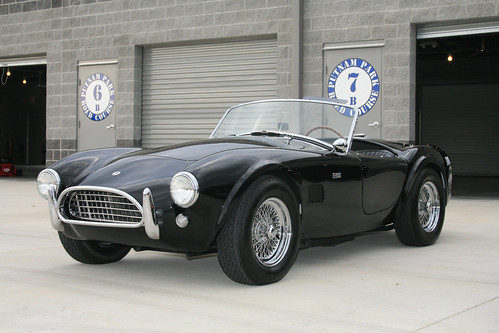 The Shelby Cobra is named after the famed 24-hour Le Mans winner and racing school owner, Carroll Shelby, who wanted to develop his ideal machine bearing his name. Shelby had experience racing an AC Ace early in his career, and he was impressed with its handling and lithesome aluminum body. Shelby struck a deal with the American Ford Company and British owned AC. With Ford supplying the engines and AC selling the hybrid cars under their name in the UK, Shelby American was formed to build and market the Shelby Cobra in the US. The Shelby Cobra beat Ferrari for the World Championship in 1965, and went on to win Le Mans in 1966 and 1967, fulfilling Carroll Shelby’s desire to defeat and humiliate Ferrari with an American-made racecar.
The Shelby Cobra is named after the famed 24-hour Le Mans winner and racing school owner, Carroll Shelby, who wanted to develop his ideal machine bearing his name. Shelby had experience racing an AC Ace early in his career, and he was impressed with its handling and lithesome aluminum body. Shelby struck a deal with the American Ford Company and British owned AC. With Ford supplying the engines and AC selling the hybrid cars under their name in the UK, Shelby American was formed to build and market the Shelby Cobra in the US. The Shelby Cobra beat Ferrari for the World Championship in 1965, and went on to win Le Mans in 1966 and 1967, fulfilling Carroll Shelby’s desire to defeat and humiliate Ferrari with an American-made racecar.
The 1966 Shelby Cobra 427 Super Snake made history on January 21, 2007, fetching $5.5 million at the Barrett-Jackson Collector Car Auction, with a world record price for an American car, auction organizers said.
Jack recalled the bull market for collector cars when he wanted to purchase his Cobra. “I purchased my Shelby Cobra 289 in 1990 after a big run-up in car prices in ’86 and ’87,” he said. “I watched as the auction prices started coming back down in ‘88, ’89 and ’90. I thought, if I’m going to get one, now’s the time.”
After extensive research on how to identify original Shelby Cobras, he met with a couple of Cobra owners from Indiana so he could gain practical knowledge as he began his search. Pre-Internet days, Jack could only call around and research classifieds like Hemmings Motor News Magazine. “I found one that I thought was original and had a friend go out and look at the car,” Jack said. His friend confirmed that it was indeed, original. Jack flew out to Iowa to see the car for himself. “The gentleman who owned it was a collector and had one of the 427 Cobras that was owned by Carroll Shelby,” he explained. “He also had 350R’s.” The 350R was a race spec car built specifically for competition, and not for cruising the local Dairy Queen.
“The 289 was the owner’s least favorite car,” Jack recalled. “It was in original condition with very old tires. I arranged for transportation and brought it back to Indy. It didn’t really need much cosmetic work. I cleaned it up and out of my cars in my collection, this was the one I drove the most. I decided to do light restoration in the interior and the thickness of the seat cushions was increased as they were redone. Now all of a sudden my knees were smashed into the dash and I could barely get into it, as I’m almost 6’5”.
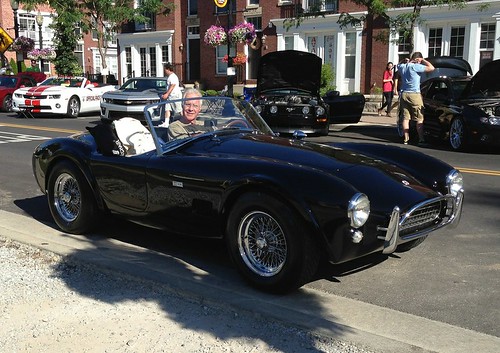 “It just wasn’t comfortable anymore. At that time the prices were going down again and I convinced myself that this was the time to get out.” In addition to his physical discomfort, Jack also went through a division of personal property and assets with his now ex-wife. Jack ultimately sold his car in 1999 feeling immediate seller’s remorse.
“It just wasn’t comfortable anymore. At that time the prices were going down again and I convinced myself that this was the time to get out.” In addition to his physical discomfort, Jack also went through a division of personal property and assets with his now ex-wife. Jack ultimately sold his car in 1999 feeling immediate seller’s remorse.
Jack’s 289 was sold to a broker who then sold it to another gentlemen who kept it for a while. It was sold once more to another gentleman who put Jack’s Cobra through a “nuts and bolts” type of restoration, keeping everything original and keeping the original drivetrain. After that owner’s death, his estate decided to sell it.
“On my side of the story, I was suffering seller’s remorse and put it out of my mind for a while,” Jack said. “I began watching the Mecum auctions on TV and I saw the prices going up and up and then suddenly, they dipped. I went to a Mecum auction in spring of 2010 and they had a 289 that looked just like mine. It didn’t sell and I looked at it and even talked to Mecum’s son. He didn’t have a lot of information other than what was on his paperwork and he told me to come back the next day to talk with their expert on Cobras. Colin Comer, Mecum’s expert, wrote a book on Cobras, among others, and he confirmed that the car I was viewing was the real car, but it was not the real engine and it had modifications. “
I made a bid anyway and luckily, it wasn’t accepted. I chose to pass on that one and kept watching the auctions and checking in with Comer periodically with questions regarding the Cobras.” At one point, Comer advised Jack to “just go and buy his book.” One random day, Jack received an email from Comer. “Out of the blue I got an email from him,” Jack explained. “Comer said, ‘I know where your car is. Would you like to purchase it?’ I wrote him back and asked, ‘Is it like my car, or is it my car?” Every Shelby ever made is registered in an official registry. Comer had researched this.
Comer replied, “It is number 2573. If you’re Jack Farr, it is your car.” Comer brokered the deal and Jack paid 4 times the amount that he had sold it for originally but was nonetheless happy to get it back. “Comer brought it back to his shop in Milwaukee, WI, and then I brought it back here and I’ve had it ever since,” Jack said. “In my opinion, what makes the Shelby Cobra so unique is the fact that it was the first car Carroll Shelby put his hands on. He put a big engine in a small car and the car at that time was just so light for that engine. It remains powerful even by today’s standards.”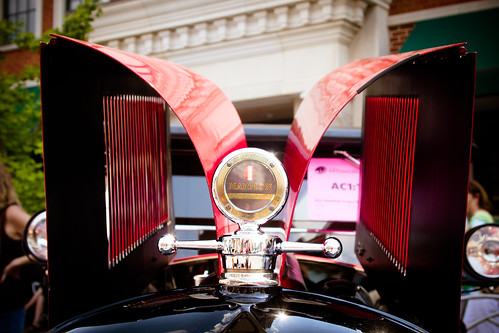
The Wisdom of Carroll Shelby
He loved to stick $100 bills to the inside of the windscreen and challenge the potential customer, sitting in the passenger seat, to grab the bill before the Cobra hit 100 mph.
“The reason I moved to California the first time was to build the Cobra. I thought it was stupid to have a 1918 taxicab engine in what Europeans like to call a performance car when a little American V8 could do the job better.”


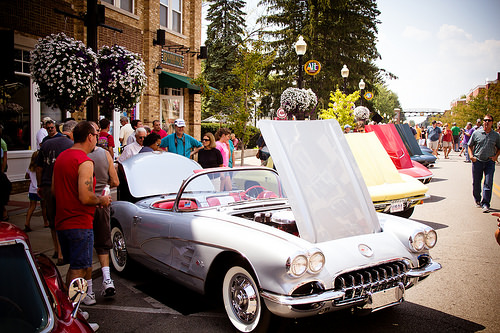

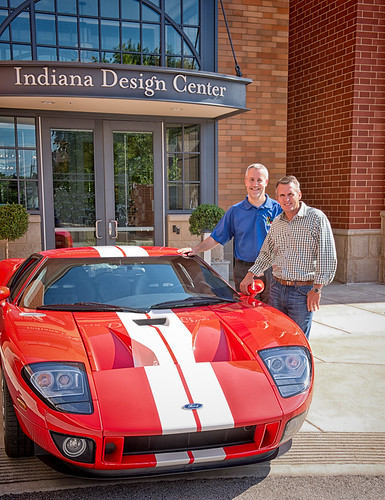 The Years Behind the Gears: A Tale of Two Cars and the Men Who Drive Them.
The Years Behind the Gears: A Tale of Two Cars and the Men Who Drive Them.

